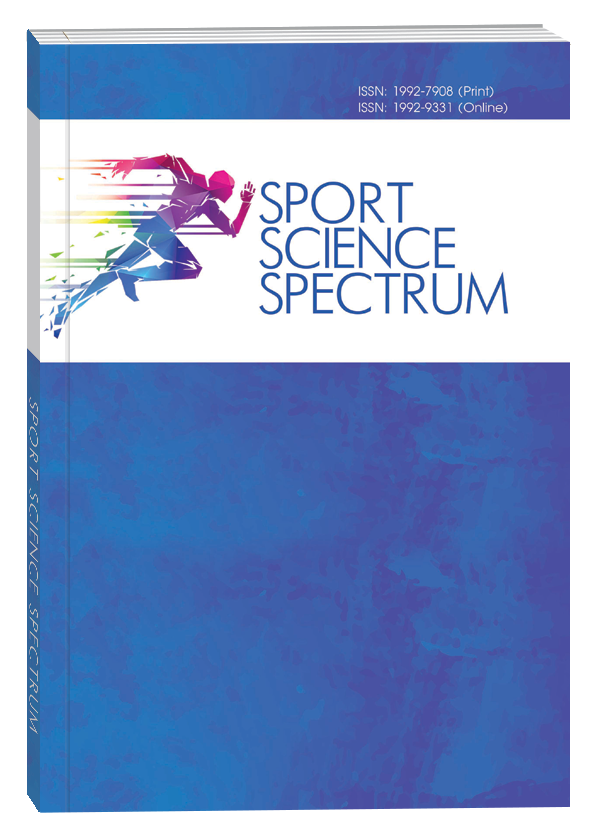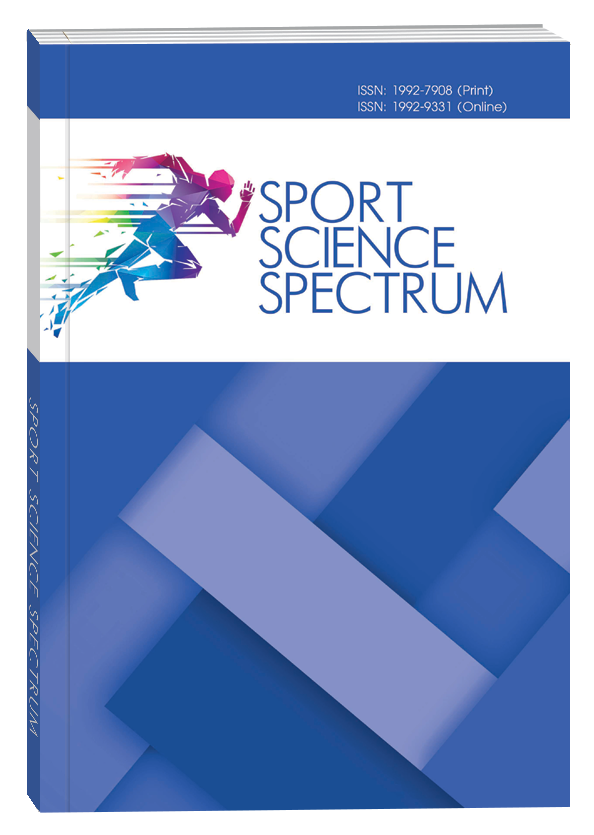CONCEPTUAL MODEL FOR THE DEVELOPMENT OF WOMEN’S BOXING AND PROSPECTIVE DIRECTIONS FOR ITS IMPLEMENTATION
DOI:
https://doi.org/10.32782/spectrum/2025-2-13Keywords:
women’s boxing; conceptual model; long-term athlete development; gender policy in sport; sports governance; Olympic sport.Abstract
Abstract. Introduction. Women’s boxing is shifting from adapting “male” training models to establishing its own paradigm of preparation, safety, and governance. Against the backdrop of Olympic legitimization and growing participation, there is a pressing need for a long-term development strategy that integrates sporting, biomedical, and sociocultural dimensions. Purpose. To develop and substantiate a conceptual model for the long-term development of women’s boxing in Ukraine, identifying strategic objectives, principles, and directions for implementation in the context of current challenges within the international sports movement. Methods. Analysis of scholarly and methodological literature and regulatory documents; synthesis of competition statistics for female athletes; expert generalization of coaching experience; and conceptual modeling to formalize goals, principles, and implementation mechanisms. Results. A model was formulated encompassing four interrelated vectors: (1) increasing participation and engaging girls; (2) optimizing long-term athlete development with regard to sex- and age-specific characteristics and evidence-based safety protocols; (3) enhancing international competitiveness via improvements to training and competition scheduling; and (4) institutional sustainability–developing infrastructure, coordinating governance structures, and expanding women’s participation in decision-making. Practical mechanisms are proposed: updating curricula, establishing standards for functional-state monitoring, introducing regulatory provisions for early stoppage in bouts with clear dominance, and supporting club- and school-based pathways. Conclusions. Implementing the model aligns preparation with female athletes’ biological characteristics, improves safety and competitive quality, strengthens governance capacity, and creates conditions for the sustainable growth of women’s boxing and successful performances on the international stage.
References
1. Бєлих С. І. Дівочий бокс: Підручник. 2-ге вид. Донецьк : ДонНУ, 2004. 624 с.
2. Бокс: жінки: навчальна програма для ДЮСШ, СДЮСШОР, ШВСМ / уклад. М. О. Діленян, В. Н. Ост’янов, Г. І. Комісаренко, І. А. Гурович, Ю. В. Шевчук. Київ : Республіканський науково-методичний кабінет, 2009. 112 с.
3. Булатова М. М. Бокс. Енциклопедія в запитаннях і відповідях. Київ : Олімпійська література, 2018. 576 с.
4. Гасанова С. Ф. Жіночий бокс. Методичні рекомендації. Київ : КНУБА, 2014. 26 с.
5. Гасанова С.Ф. Структура функціональної підготовленості спортсменок високого класу як фактор забезпечення змагальної діяльності в жіночому боксі : дис. … канд. фіз. вих. : 24.00.01. Київ, 2021. 248 с.
6. Конох А., Воронцов А. Пріоритетні напрями вдосконалення системи підготовки у жіночому боксі. Спортивний вісник Придніпров’я. 2019. № 3. С. 11–18. DOI: 10.32540/2071-1476-2019-3-011
7. Марченко О., Цикало Л., Бричук М., Сімоненко Н. Гендерна проблематика у фізичному вихованні: історико-філософський аналіз. Слобожанський науково-спортивний вісник. 2020. №. 6 (80). С. 22–31. DOI: 10.15391/snsv.2020-6.004
8. Платонов В. М. Сучасна система спортивного тренування : підручник. Київ : Перша друкарня, 2021. 672 с.
9. Тарасевич О. А., Камаєв О. І. Особливості гендерних відмінностей спортсменів, що займаються спортивними єдиноборствами. Єдиноборства. 2019. №4(14). С. 117–126. DOI: https://doi.org/10.31435/rsglobal_ws/30012021/7413
10. Штанагей Д., Савенюк А. Особливості змагальної діяльності боксерок на чемпіонаті Європи 2023 року. Єдиноборства. 2025. № 2(36). С. 41–46. DOI: https://doi.org/10.15391/ed.2025-2.05
11. Alimova D. Female boxing – problems. European journal of research and reflection in educational sciences. 2020. № 8(10). Р. 118–123. https://www.idpublications.org/wp-content/uploads/2020/10/Full-Paper-FEMALE-BOXING-%E2%80%93-PROBLEMS.pdf
12. Bennett L., Stephen S., Bernick C., Shan G., Banks S. Sex Moderates the Relationship That Number of Professional Fights Has With Cognition and Brain Volumes. Front Neurol. 2020. № 11. DOI: 10.3389/fneur.2020.574458
13. Bianco M., Nicola S., Bucari S., Fabiano C., Palmeri V., Zeppilli P. Female boxing in Italy: 2002 – 2007 report. British Journal of Sports Medicine. 2012. № 46. P. 1023–1026. DOI: 10.1136/bjsm.2009.061135
14. Bojkowski Ł., Walczak M., Tomczak M. Psychological femininity and masculinity and coping with stress in athletes. Journal of Physical Education and Sport. 2020. № 20(5). Р. 2911–2917. DOI: 10.7752/jpes.2020.s5395
15. Bompa T., Haff G. G. Periodization: theory and methodology of training. [5th ed.]. Champaign IL : Human Kinetics, 2009. 480 p.
16. Borms J. Women and Sport. Basel : Karger, 1984. 165 p.
17. Csizma K., Wittig A., Schurr T. Sport stereotypes and gender. Journal of Sport and Exercise Psychology. 1988. №10. P. 62–74. DOI: https://doi.org/10.1123/jsep.10.1.62
18. Gammel I. Lacing Up the Gloves. Women, Boxing and Modernity. The Journal of the Social History Society. 2015. № 9. P. 369–390. DOI: https://doi.org/10.2752/147800412X13347542916620
19. Guttmann A. Women’s Sports: A History. New York : Columbia University press, 1991. 339 p.
20. Hargreaves J. Women’s boxing and related activities. Body & Society. 1997. № 3(4). P. 33–49. DOI: https://doi.org/10.1177/1357034X97003004002
21. Howell D. R., Meehan W. P., Loosemore M. P., Cummiskey J., Grabner von Rosenberg J. P., McDonagh D. Neurological test improve after Olympicstyle boxing bouts: a pretournament and post-tournament study in the 2016 Women’s World Boxing Championships. Br. J Sports Med. 2017. № 51(17). P. 1279–1284. DOI: 10.1136/bjsports-2016-097160
22. Hunter S. K. Sex differences in human performance. The Journal of Physiology. 2024. № 602(17). Р. 4129–4156. DOI: 10.1113/JP284198
23. Jansen A., McGrath M., Samorezov S., Johnston J., Bartsch A., Alberts J. Characterizing Head Impact Exposure in Men and Women During Boxing and Mixed Martial Arts. Orthop J Sports Med. 2021. №. 7;9(12). 232596712110598. DOI: 10.1177/23259671211059815
24. Linder K. Women’s boxing at the 2012 Olympics: Gender trouble? Feminist Media Studies. 2012. Vol. 12, № 3. P. 464–467. DOI:10.1080/14680777.2012.698092
25. Tjonndal A. The inclusion of women’s boxing in the Olympic Games: A qualitative content analysis of gender and power in boxing. Qualitative Sociology Review. 2016. Vol. 12, №3. P. 84–99. DOI: http://dx.doi.org/10.18778/1733-8077.12.3.04
Downloads
Published
Issue
Section
License

This work is licensed under a Creative Commons Attribution-NonCommercial 4.0 International License.





